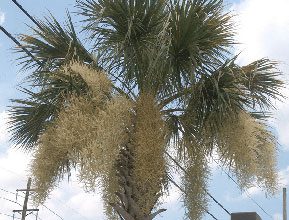 July is when our countless palmetto trees display their huge panicles of tiny, pale blooms, thousands of them on each blooming branch and often several of the great white-flowered masses on each palmetto tree.
July is when our countless palmetto trees display their huge panicles of tiny, pale blooms, thousands of them on each blooming branch and often several of the great white-flowered masses on each palmetto tree.
August is when you begin to see the tree crews with their bucket trucks and extension saws cutting off these massive flowering branches.
Is that good? Is it necessary? What about those old fronds, those big palm leaves that aren’t all green and are hanging down – can’t I cut those out?
It does no actual harm to the palmetto itself to remove those big flowering branches at any stage, from just appearing to when the seeds arrive. Now, I am talking here only about the flowering branches – you can do harm to the tree if you cut the palm fronds without knowing what you’re doing. I’ll get to that in a moment.
Once a palmetto has reached substantial size, it is a major task to try to reach the crown and saw off any of the bloom stalks. The tree can be forty feet tall or more. That’s hardly a job for a ladder and a limb saw; that’s why professional tree crews are the ones doing most of this kind of work.
The home gardener can, however, take care of the bloom stalks on much smaller palmetto trees in the landscape, and for most purposes the curved limb saw used for shrubs and trees should work just fine.
But before you do cut out those flowering branches, think about what effect you’re having on the garden. To be sure, while the thousands and thousands of flowers are there, a granular layer of spent flowers accumulates on any sidewalk or pavement below. You can sweep it twice a day, and it’s still a mess. And how about the seeds, those hard little black-brown pills that seem to fall by the million once they’re ripe? Not only are they a real mess; they act like ball bearings for anyone who walks on them. And you’re assured of thousands of volunteer palmetto seedlings coming up everywhere.
So it’s understandable that someone with palmettos above walking surfaces would much prefer to cut out the offending flowering stalks than have to clean the deck or sidewalk daily.
to cut out the offending flowering stalks than have to clean the deck or sidewalk daily.
But for trees not affecting the safety of pedestrians and others, perhaps you’d do well to consider leaving those blooms and seeds on to mature. The flowers are superbly rich in nectar, attracting pollinators – especially honeybees. Turkeys, cardinals, grackles, blue jays, and many other birds devour the ripened seeds with gusto. Palmettos are a very significant food source for wildlife, and it is by allowing the flowers and seeds to develop that we can contribute to wildlife’s benefit.
What about those ugly fronds that look like they’ve given up the ghost? Do we cut those off, or leave them?
While once upon a time it was common practice to trim off most of the fronds on landscape palmettos before hurricane season, research has shown that the practice does not reduce damage to the trees from high winds. Instead, it seems that the trees are more likely to snap off in a storm, and the loss of vital green leaves seriously reduces the trees’ ability to recover and generate new growth.
 So, before considering pruning back landscape palmettos, pay special attention to retaining as much of the green fronds in the crown as possible. If it seems necessary to cut some of the fronds, best practices insist on removing only those fronds which bend down below the horizontal.
So, before considering pruning back landscape palmettos, pay special attention to retaining as much of the green fronds in the crown as possible. If it seems necessary to cut some of the fronds, best practices insist on removing only those fronds which bend down below the horizontal.
And what about those fronds which are no longer bright green and healthy?
It is known that the fronds which are not yet fully brown – that is, any fronds which still have a bit of green in the petiole, or stem – still provide essential nutrients to the rest of the tree. A healthy tree will draw vital minerals and nutrients from a seemingly dying frond to benefit the health of the entire tree.
So be cautious about removing any of those yellowing fronds which seem to serve no purpose for the tree.
Then there are those old brown fronds which have long seen their best days, hanging down, ever closer to the trunk below the crown. These are the ones that almost universally make people feel like they absolutely must trim them off.
Removing these fronds probably will not do any harm directly to the palmetto tree itself. But, once again, these fronds provide shelter and nesting for countless species of wildlife: raccoon, o’possum, birds of all sorts. And, of course, palmetto bugs. But so does that expensive mulch you put out. You’re going to have the palmetto bugs, anyway, whether you have palmettos, or not.
The big glaring exception to the “don’t-chop-it-all-off” rules is when you’re transplanting a palmetto. It is accepted practice to remove all but the few emerging fronds at the growing tip of the tree.
This is because, when the tree is dug, all of its root system is damaged so badly that all its roots die back. This means there is no provision for water and nutrients to reach the fronds at the top, so they will die, as well. There is sufficient water and nutrients stored in the trunk for the tree to support those emerging leaves, and to begin the process of replacing the damaged root system, which it will do quite quickly.
That is why palmettos being transplanted have been stripped of their fronds. “Cut it all off” turns out to be the right thing for once!








